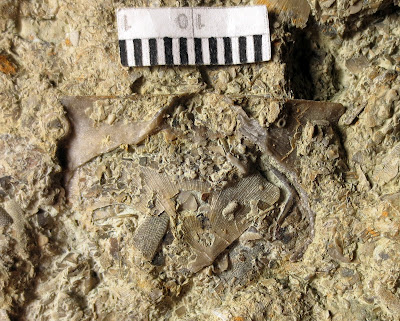More specifically, it weighs 13.7 pounds (6.21 kg), or, appropriately enough, almost one stone. At the time I picked it up, from a road work spoil pile, it weighed a bit more because there was still a lot of Decorah mud sticking to it. (I was already carrying several rocks, but one of the funny things about collecting is when you spot something of interest, the size of the piece and the nature of the terrain between you and it magically become irrelevant. If the universe has designated you for comic relief, the size or the terrain will suddenly become relevant at the least convenient time.) My interest was drawn by one particular object, which you may have already spotted if you embiggened the photo. I've circled it in the next photo.
This is a hypostome, or mouth part, from a large trilobite of the genus Isotelus, the local champion of Ordovician trilobites. The Isotelus it belonged to would have been several inches long.
Like any other organism, this Isotelus did not live and die in a vacuum, a featureless seafloor void. What other kinds of fossils can be seen on the same side of the slab?
Mud sticking to fossil-bearing slabs is an aspect of Decorah collecting that leads to both surprises and frustration: surprises, because you won't know what you've really got until the mud's gone; and frustration, because sometimes you get a dud, and there's a tendency for fossils you may have preferred to stay attached to the slab to come off due to only being held on by the mud in the first place. In this case, all I had to go on when I found the slab was the hypostome, but I figured it made the piece worth collecting all by itself. Cleaning revealed first of all that there were also several large partial strophomenid brachiopod shells, the most complete of which are circled in the next photo. They are all convex-up, indicating we're either looking at the underside of a bed and the shells are in life position, or we're looking at the top of a bed and the shells have been flipped. (I will add, for those of you who like to ponder taphonomy and sedimentology, that the B-side of the slab seems to have somewhat more medium and large-ish pieces than this side, although maximum grain size is not as large as on this side [i.e., this side we're looking at has a few big pieces and a lot of tiny bits, but not as much in between], and the strophs on the B-side are concave-up. We can look at the B-side some other time.)
As noted, the strophs are incomplete, with the central portions of the arched shells lost. The thinness and fragility of stroph shells means they are vulnerable to damage at pretty much any time; because these are on an outer surface of a slab, they could have been lost through recent frost-wedging at the interface between the rock and the clay, or simply washed away during my removal of clay.
Several other kinds of brachiopods are apparent, although not generally well exposed or well preserved. They are all smaller than the strophs, and can be most readily distinguished by having a pointed hinge instead of a straight hinge line, or by being made of a different material.
Bryozoans are common on this side, but are almost exclusively small chips and other fragments of strap-like to branching fronds, with few larger pieces. Other common types of Decorah bryozoan shapes, such as sheet-like, irregular, thick cylindrical, and domed, are not apparent.
 |
| These are a couple of the largest pieces; similar fronds broke up to form a significant part of the matrix of fossil fragments. |
Crinoid columnals are relatively uncommon on this side, although there is one segment of several articulated columnals that has been partially encrusted by a bryozoan colony. This association is the kind of thing that once you've recognized a couple of examples, you start to see frequently. (If you see a bryozoan cylinder with evenly-spaced ridges or rings of bumps, you're looking at a colony that has completely engulfed part of a stem.) While I suppose an encrustation could form before or after the crinoid died, I suspect that the best examples at least began to form during the lifetime of the crinoid, because of the propensity for crinoid stems to break up. In this case, the encrustation is only partially developed, allowing us to more easily see the partially engulfed columnals.
The great bulk of the fossils are a fine hash. Tiny fragments of bryozoans and brachiopods can be identified, alongside uncountable unidentifiable bits and pieces. Large identifiable fossils are relatively rare; aside from the highlighted fossils, there is also a mostly buried bellerophont (which inevitably takes a poor photo). There is also this interesting structure on a shell, apparently some kind of tiny holdfast or attachment scar.








No comments:
Post a Comment